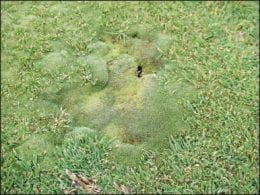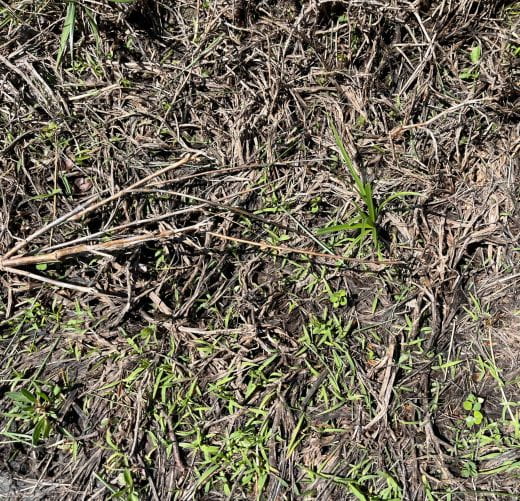 Photo shows crabgrass emerging in Olathe, Kansas near a paved walking path in a park area. Greater soil warmth allows for earlier emergence in these areas. The photo was taken on April 21.
Photo shows crabgrass emerging in Olathe, Kansas near a paved walking path in a park area. Greater soil warmth allows for earlier emergence in these areas. The photo was taken on April 21.
Category: Weeds
Enhance Effectiveness of Preemergence Herbicide Application
This blog post was presented last year, but we’re approaching that time of year again when crabgrass and other annual grassy weeds are approaching emergence.

As a reminder, if you want more detailed information on weed control in general, consider getting this 2022 publication that was developed by several state universities, including K-State, and was led by Purdue: “Weed Control for Turfgrass Professionals”
Preemergence herbicide applications for crabgrass, goosegrass, foxtail, and other annual grasses are underway. Here are bullet points to consider to increase the efficacy of the herbicide you use.
Maintain turf density and mow higher. Good turf density resulting from proper cultural practices for the grass you’re managing reduces encroachment of all weeds, including annual grasses. Mowing at the higher end of the recommended range has consistently shown significantly lower populations of crabgrass and other annual grasses than mowing at lower mowing heights.
Apply before emergence. Not all annual grass species emerge at the same time. For example, goosegrass emerges later than crabgrass. However, even within a species, emergence of new seedlings occurs throughout spring and summer. With most preemergence herbicides, when seedlings have emerged, they will not effectively control those plants. However, the application will control emergence of grasses beyond that date. Dithiopyr (Dimension) does provide control of crabgrass that has emerged but has not begun to produce tillers.
Use effective strategies to guide application. Calendar dates, soil temperature, flowering of ornamentals, and other strategies are all used to help guide applications and maximize herbicide residual during the period annual grasses emerge. Here are a few articles related to this subject:
How Preemergence Herbicides Work and Why They Fail (Univ. of Nebraska)
https://blogs.k-state.edu/turf/methods-of-predicting-crabgrass-emergence/
https://blogs.k-state.edu/turf/flowering-ornamentals-and-crabgrass-emergence/
Apply uniformly. Uniform application is critical – just like distributing paint evenly over your house is aesthetically pleasing. If you leave a section of the house unpainted, it’s clearly visible. Good annual grass control requires uniform application; if an area is not treated, it’s likely you’ll seed weed emergence there. Uniform application is achieved by proper spreader or sprayer calibration, colorants that indicate areas that have been treated with liquid products, and applying the product in two directions (half rate in each).
Split applications. Some, not all, preemergence herbicides generally provide better suppression of annual grasses when applications are split (1/2 rate each application), usually 6 to 8 weeks apart. This allows a higher level of herbicide presence on the soil surface, which will minimize weed emergence. Here’s an article from Purdue on this subject:
https://turf.purdue.edu/wp-content/uploads/2012/06/15_AGRY_Patton_sequential20apps.pdf
Water in after application. For preemergence herbicides to be activated and ensure uniform distribution on the soil surface, irrigation (or rainfall) after application is needed.
Find more information on weed control by clicking on the tags on the blog (left column), such as “weed control,” “crabgrass,” etc., or search by category on the right side of the page.
***Mention of trade names or commercial products in this article is solely for identification purposes and does not imply recommendation or endorsement, nor is criticism implied of similar products not mentioned by Kansas State University.***
Don’t forget to follow the K-State Turf and Landscape Team on Twitter @KSUTURF
Also, visit our facebook page www.facebook.com/KSUTurf
Herbicide Options at the time of Spring Seeding
 The option for spring seeding is approaching. Cool-season grasses may have been seeded in the winter months, or can be seeded in spring – preferably in March and April in Kansas. Cool-season seed germination typically starts when the soil temperature reaches 50 F. Of course, fall seeding is preferred, but we are often dealing with situations where turf quality needs to be improved with spring seeding. One of the difficult problems is dealing with the emergence of summer annual weeds as the desired turfgrass species you’ve seeded begins to emerge. Here are herbicides that can be applied at the time of seeding to suppress summer annuals:
The option for spring seeding is approaching. Cool-season grasses may have been seeded in the winter months, or can be seeded in spring – preferably in March and April in Kansas. Cool-season seed germination typically starts when the soil temperature reaches 50 F. Of course, fall seeding is preferred, but we are often dealing with situations where turf quality needs to be improved with spring seeding. One of the difficult problems is dealing with the emergence of summer annual weeds as the desired turfgrass species you’ve seeded begins to emerge. Here are herbicides that can be applied at the time of seeding to suppress summer annuals:
Tupersan (active ingredient siduron)
Siduron is a preemergence herbicide that can be used on cool-season grasses. It does provide weed suppression, but don’t expect the same level of weed control that we get with products that are commonly used on fully established turf. It is approved for used on colonial bentgrass, creeping bentgrass, Kentucky bluegrass, perennial ryegrass, tall fescue. To view a Tupersan label, CLICK HERE
Tenacity (active ingredient meotrione)
Mesotrione inhibits photosynthesis in weeds once absorbed by shoots or roots. It originated based upon biochemicals observed in the plant called bottlebrush (Callistemon citrinus). It suppresses weeds as they absorb the herbicide at time of emergence and can also be used as a postemergence product. Midwest grasses for which it is labeled include buffalograss, Chewings fescue, creeping red fescue, hard fescue, Kentucky bluegrass, perennial ryegrass, and tall fescue. To view a Tenacity label, CLICK HERE
A number of other herbicides can be used once turfgrass reaches a point of maturity after seeding. Find more details about postemergence herbicides that can be used after seeding, and all information about turf weed by getting a copy of the 2022 edition of Turfgrass Weed Control for Professionals

Find more information on weed control by clicking on the tags on the blog (left column), such as “weed control,” “crabgrass,” etc., or search by category on the right side of the page.
***Mention of trade names or commercial products in this article is solely for identification purposes and does not imply recommendation or endorsement, nor is criticism implied of similar products not mentioned by Kansas State University.***
Two-Minute Turf Extension Video: Impact of Nitrogen on Weed Encroachment
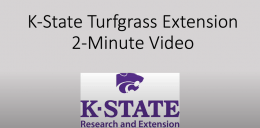 This new blog video gives an update on a research project, a turf-related issue, or current concerns in the turf industry. Each one will be approximately 2 minutes long – you’ll see one periodically!
This new blog video gives an update on a research project, a turf-related issue, or current concerns in the turf industry. Each one will be approximately 2 minutes long – you’ll see one periodically!
On this video, the first one, see the impact of nitrogen fertilization on crabgrass encroachment in a field project at the Olathe Horticulture Center. This study is being done at several universities in the north central U.S. including Iowa State, Michigan State, Minnesota, Missouri, Nebraska, North Dakota State, Ohio State, and Wisconsin. Most are looking at weeds in cool-season grasses, but you’ll hear about bermudagrass here.
Nutsedge is Showing Up
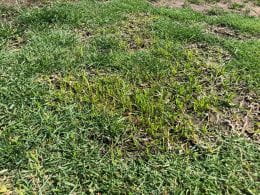
It’s springtime and sedges are beginning to show up. Sedges are different than broadleaf and grassy weeds, and require different control strategies. Yellow nutsedge is the common sedge problem in our area. Treating yellow nutsedge when it’s young and just starting to appear is a good strategy that will result in better control.
Yellow nutsedge spreads primarily through its production of tubers and rhizomes – all can contribute to its expansion within a lawn.
Great resources to learn more about sedge control:
How to Enhance Efficacy of Preemergence Herbicides (and get Weed Control for Professionals publication!)
By Dr. Jack Fry
This blog post was presented last year, but we’re approaching that time of year again when crabgrass and other annual grassy weeds are approaching emergence.
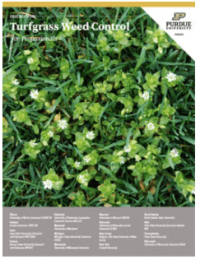
As a reminder, if you want more detailed information on weed control in general, consider getting this publication that was developed by several state universities, including K-State, and was led by Purdue: “Weed Control for Turfgrass Professionals”
Preemergence herbicide applications for crabgrass, goosegrass, foxtail, and other annual grasses are underway. Here are some bullet points to consider to increase the efficacy of the herbicide you use.
Maintain turf density and mow higher. Good turf density resulting from proper cultural practices for the grass you’re managing reduces encroachment of all weeds, including annual grasses. Mowing at the higher end of the recommended range has consistently shown significantly lower populations of crabgrass and other annual grasses than mowing at lower mowing heights.
Apply before emergence. Not all annual grass species emerge at the same time. For example, goosegrass emerges later than crabgrass. However, even within a species, emergence of new seedlings occurs throughout spring and summer. With most preemergence herbicides, when seedlings have emerged, they will not effectively control those plants. However, the application will control emergence of grasses beyond that date. Dithiopyr (Dimension) does provide control of crabgrass that has emerged but has not begun to produce tillers.
Use effective strategies to guide application. Calendar dates, soil temperature, flowering of ornamentals, and other strategies are all used to help guide applications and maximize herbicide residual during the period annual grasses emerge. Here are a couple of articles related to this subject:
https://blogs.k-state.edu/turf/methods-of-predicting-crabgrass-emergence/
https://blogs.k-state.edu/turf/flowering-ornamentals-and-crabgrass-emergence/
Apply uniformly. Uniform application is critical – just like distributing paint evenly over your house is aesthetically pleasing. If you leave a section of the house unpainted, it’s clearly visible. Good annual grass control requires uniform application; if an area is not treated, it’s likely you’ll seed weed emergence there. Uniform application is achieved by proper spreader or sprayer calibration, colorants that indicate areas that have been treated with liquid products, and applying the product in two directions (half rate in each).
Split applications. Preemergence herbicides generally provide better suppression of annual grasses when applications are split (1/2 rate each application), usually 6 to 8 weeks apart. This allows a higher level of herbicide presence on the soil surface, which will minimize weed emergence. Here’s an article from Purdue on this subject:
https://turf.purdue.edu/wp-content/uploads/2012/06/15_AGRY_Patton_sequential20apps.pdf
Water in after application. For preemergence herbicides to be activated and ensure uniform distribution on the soil surface, irrigation (or rainfall) after application is needed.
Find more information on weed control by clicking on the tags on the blog (left column), such as “weed control,” “crabgrass,” etc., or search by category on the right side of the page.
***Mention of trade names or commercial products in this article is solely for identification purposes and does not imply recommendation or endorsement, nor is criticism implied of similar products not mentioned by Kansas State University.***
Don’t forget to follow the K-State Turf and Landscape Team on Twitter @KSUTurf
Also, visit our facebook page www.facebook.com/KSUTurf
Field Day Videos on Pest Management – See these Speakers at Conference!

Here are video recordings of field day presentations (last August) of a few speakers you’ll hear at the Kansas Turf and Landscape Conference, which is in Manhattan, KS on December 1 and 2. You can’t get pesticide recertification credit by watching the videos below, but you can if you come to the conference (7 cr. of 3A and 3B will be available!).
Field Day recordings – Click on the name to see it!
Dr. Raymond Cloyd – Insect Update
Dr. Megan Kennelly – Disease Update
Sessions at the upcoming conference include Basic Turf; Nursery & Landscape; Diseases, Insects & Weeds; Advanced Turf; and Sustainability, Technology & Water Management. You can download the conference brochure and get exhibitor information by CLICKING HERE!
Complete online registration by CLICKING HERE!
Autumn is the Right Time for Broadleaf Weed Control
 Cool-season broadleaf weeds, including winter annuals and perennials, wait until temperatures cool down and then emerge during autumn. The photo above was taken in Olathe in late October. Targeting broadleaf weeds during autumn, when temperatures are suitable for application, results in good broadleaf weed control. Immature weed seedlings are more susceptible to herbicides than mature weeds. Find more information regarding weed control in this valuable resource. The updated “Turfgrass Weed Control Guide for Professionals – 2021” provides weed identification and control information that turfgrass professionals can use to develop effective weed control programs for golf courses, athletic fields, sod farms, lawns, and other turfgrass systems. The recommendations apply to the majority of the United States, with input from experts in Illinois, Indiana, Iowa, Kansas, Kentucky, Michigan, Minnesota, Missouri, Nebraska, New Jersey, New York, Ohio, Pennsylvania, and Wisconsin.
Cool-season broadleaf weeds, including winter annuals and perennials, wait until temperatures cool down and then emerge during autumn. The photo above was taken in Olathe in late October. Targeting broadleaf weeds during autumn, when temperatures are suitable for application, results in good broadleaf weed control. Immature weed seedlings are more susceptible to herbicides than mature weeds. Find more information regarding weed control in this valuable resource. The updated “Turfgrass Weed Control Guide for Professionals – 2021” provides weed identification and control information that turfgrass professionals can use to develop effective weed control programs for golf courses, athletic fields, sod farms, lawns, and other turfgrass systems. The recommendations apply to the majority of the United States, with input from experts in Illinois, Indiana, Iowa, Kansas, Kentucky, Michigan, Minnesota, Missouri, Nebraska, New Jersey, New York, Ohio, Pennsylvania, and Wisconsin.
CLICK HERE to purchase the Turfgrass Weed Control Guide for Professionals – 2021
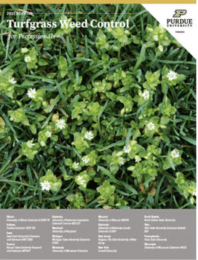
This guide will also be available for sale at the Kansas Turf and Landscape Conference on December 1 and 2, 2021 in Manhattan, KS. You can download the conference brochure and get exhibitor information by CLICKING HERE! Complete online registration by CLICKING HERE!
Seeding after Herbicide Application
By Daniele McFadden (recent M.S. graduate at K-State)
With spring in full swing many of you are taking advantage of the warm soil temperatures and overseeding turf areas. Often times we can mistakenly coincide our spring-time herbicide applications with seeding cool-season turf. So, are your new seedlings going to mature and develop if this happens? Research was done over the last two years to evaluate how several herbicides affect the emergence and growth of tall fescue and Kentucky bluegrass when seeded after application. Following are some takeaways from these experiments.
The good:
- When dandelions and other common broadleaves start to appear, a standard three-way postemergence broadleaf product containing 2,4-D + MCPP + dicamba (numerous trade names) is often applied. In both the field and greenhouse, we found that seeding tall fescue into an area treated with this herbicide combination was safe on the seedlings, and was comparable to tall fescue growth in areas where the herbicide wasn’t applied.
- Other combination products used for control of broadleaf weeds were found safe on tall fescue seedlings when seeding was done 0 to 14 days after herbicide application. These herbicides included:
- Carfentrazone-ethyl + MCPP + 2,4-D + dicamba (SpeedZone)
- Fluroxypyr + halauxifen-methyl + 2,4-D (GameOn)
- Triclopyr + pyraflufen-ethyl + 2,4-D + dicamba (4-Speed XT)
The bad:
- Playing catch-up with yellow nutsedge control? Applying halosulfuron-methyl (Sedgehammer and other trade names) in late summer or early fall for the control of nutsedge could affect your tall fescue and Kentucky bluegrass seedlings if seeding occurs within two weeks of application. Both cool-season grasses emerged in the field with mild chlorotic symptoms that went away within 8 weeks after seeding. However, a closer look at root development showed that seeding tall fescue into soil treated with halosulfuron-methyl significantly stunted development. The Sedgehammer label guidelines clearly state that a four-week delay after application is needed. Plan your nutsedge control earlier in the summer so it does not interfere with early fall seeding.
The ugly:
- Did you accidentally apply a preemergence herbicide for crabgrass control before seeding? You might be wasting your seed. Our studies found that seeding tall fescue or Kentucky bluegrass into an area treated with dithiopyr (Dimension) greatly inhibited growth of the seedlings.
Bottom line – reading the label to learn how soon seeding can be done after herbicide application is critical. Labels on some of these products indicate that seeding should be done after a longer interval has passed after application compared to what was observed as required in this research. Seeding guidelines on labels must be followed; that said, research results from this project provide useful information to herbicide manufacturers and turf managers who may unknowingly seed into herbicide-treated areas.

These research results will soon appear in greater detail in K-State’s 2021 Turfgrass Research Research Report.
***Mention of trade names or commercial products in this article is solely for identification purposes and does not imply recommendation or endorsement, nor is criticism implied of similar products not mentioned by Kansas State University.***
Don’t Moss with Me
Silvery thread moss has been an increasing problem on golf course putting greens over the past couple of decades. Moss is a bryophyte, and that makes it different from most plants. It doesn’t have roots, but rather rhizoids that serve as an anchor, but aren’t as efficient at absorbing water and nutrients compared to roots. It also grows across a wide range of temperatures. It can be actively growing when creeping bentgrass or annual bluegrass appears dormant in late fall or early spring. It can also experience severe drought for months (or years), and regrow once water returns; no other weeds we deal with in turf are that resilient. Research was done on silvery thread moss over several years at K-State by graduate students Dr. Cole Thompson (now Director of Research for the USGA) and Dr. Zane Raudenbush (Dr. Raudenbush just left The Ohio State University to join Davey Tree Company). Here are some things to know regarding how management of putting greens will influence moss that came from their research:
Things that make it happier:
- Mowing lower promotes more moss encroachment. For example, research showed that mowing at 0.125 in vs. 0.157 in resulted in greater moss populations.
- Areas that are thin are susceptible to moss encroachment, so maintain turf density.
- Moss loves water. If you’re watering frequently, you’ll favor its growth.
- Soluble nitrogen applied as a liquid on a frequent interval (spoon feeding) encourages the growth of moss.
Things that help suppress it:
- Mow higher and maintain turf density.
- Water less frequently while still meeting the needs of the turf.
- Fertilize with granular products that allow slower N release.
- Core aerify, verticut, and topdress. Although some may think they could spread moss with cultivation, research has shown that moss populations can be reduced by these practices, which is due in part because the moss colonies are disturbed and allow creeping bentgrass to occupy those areas.
- Apply products for moss suppression. The most popular product used for this is Quicksilver, which contains the active ingredient carfentrazone-ethyl and is labeled for use on greens. Follow the label on Quicksilver for effective moss suppression (don’t expect complete control); using this or other products labeled for moss in combination with aforementioned cultural practices will be the best approach.
Here are some useful resources on moss:
An article on the K-State webpage that give more information on moss biology and control: https://www.plantpath.k-state.edu/extension/documents/turf/moss_2015.pdf
A video by Dr. Zane Raudebush, former K-State graduate student who conducted research on moss here and as a faculty member at The Ohio State University: https://www.turfnet.com/turfnet-tv.html/winfieldtv/raudenbush_silvery_thread_moss/
A summary of the research Dr. Raudenbush did at K-State in Golf Course Management magazine: https://www.turfnet.com/turfnettv.html/winfieldtv/raudenbush_silvery_thread_moss/
Some specifics regarding N fertilization and moss:
https://www.golfdom.com/nitrogen-fertilization-and-silvery-thread-moss/
***Mention of trade names or commercial products in this article is solely for identification purposes and does not imply recommendation or endorsement, nor is criticism implied of similar products not mentioned by Kansas State University.***
Don’t forget to follow the K-State Turf and Landscape Team on Twitter @KSUTurf
Also, visit our facebook page www.facebook.com/KSUTurf
